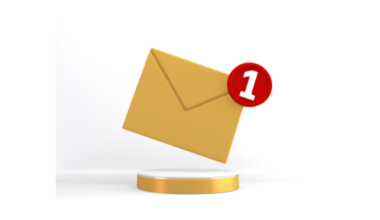
When an unaddressed email from your boss stays in your inbox, the consequences can be severe: missed deadlines, strained relationships, damaged credibility, and even delayed career advancement.
However, acknowledging their messages promptly and appropriately shows respect, reinforces your professionalism, shows your attention, and sets the tone for further communication, which is crucial in email responses.
But how do you acknowledge an email effectively, especially when you need some time to process the information and complete the task?
In today’s article, we will explore 7 effective ways to acknowledge an email from your boss in order to ensure a smooth, positive communication flow and enhance professional reactions.
Ways to Acknowledge an Email from Your Boss

1. Keep It Brief and Concise
One of the most effective ways to acknowledge an email is by keeping your response brief and to the point.
Busy professionals, including your boss, often have limited time to read lengthy replies, so a concise acknowledgment email is essential to confirm that we have received their message. A concise response not only conveys that you’ve read their message but also respects their time.
Example:
“Thank you for your email. I appreciate the update!”
Always remember that a simple acknowledgment shows that you are attentive and engaged.
It also leaves the door open for further communication without overwhelming your boss with unnecessary details, ensuring a clear and respectful dialogue with the sender that their email has been acknowledged.
Incorporating concise responses into your email etiquette will make your communication more efficient and effective while mastering the art of email acknowledgment.
It helps establish a rhythm where both you and your boss can quickly exchange information without feeling burdened by excessive correspondence, especially when emails come in frequently.
2. Express Gratitude
Another effective way to acknowledge your boss’s email is by expressing gratitude. Whether your boss has provided you with guidance, and feedback, or simply shared important information, acknowledging their efforts with a thank you can go a long way.
Example:
“Thank you for your insights on the project. I’ll incorporate your suggestions and provide an immediate response once I’ve reviewed them.”
Expressing gratitude not only shows appreciation but also fosters a positive workplace atmosphere, serving as an effective example of how to acknowledge contributions. It makes your boss feel valued and encourages a culture of recognition within your team.
Being appreciative in your emails can also help build stronger professional relationships. When your boss knows you value their input, they are more likely to invest their time and resources into your development, reinforcing the importance of timely email acknowledgement.
3. Confirm Receipt
If your boss sends important information, updates, or requests, it’s a good idea to confirm receipt. This acknowledgment assures them that their message has reached you and is being acted upon in a timely manner.
Example:
“I received your email regarding the upcoming meeting schedule and would like to acknowledge the receipt of the email.” Thank you for the acknowledgment email and the details!”
Confirming receipt provides clarity and helps eliminate any potential confusion about whether you’ve received critical information, allowing you to confirm that you’ve received the email. It reassures your boss that you are on top of things and are organized in your work.
In high-stakes environments, where projects and timelines are crucial, acknowledging receipt of an email becomes even more important.
It helps your boss feel secure knowing that you are attentive to their communications and have received the email promptly, showcasing your professionalism as a sender.
4. Highlight Next Steps
Acknowledging your boss’s email by outlining the next steps shows initiative and responsibility. This approach demonstrates that you are proactive and ready to act on the information or requests made in the email, confirming that you’ve received their message.
Example:
“Thank you for the project outline. I’ll review it and provide my feedback by Friday in a courteous manner.”
Highlighting next steps not only reassures your boss that you’re engaged but also sets clear expectations. It indicates that you are not just passively receiving information but are actively working towards outcomes by sending an acknowledgment email.
When you articulate the next steps, it can help both you and your boss align on priorities, demonstrating a professional approach to your email responses.
This clarity can lead to smoother workflow and fewer misunderstandings, making your professional relationship more effective.
5. Ask Clarifying Questions
If your boss’s email raises questions or if you need further information, don’t hesitate to acknowledge the receipt of the email and make a courteous inquiry to confirm that we have received their message.
Acknowledging their email with clarifying questions shows that you’re engaged and want to ensure that your email acknowledgment is thorough, which is a key aspect of effective communication to confirm that you’ve received their email.
Example:
“Thank you for the update! I received the email and appreciate your timely response.” Could you clarify the deadline for the project in a less formal tone?”
Asking questions not only shows your willingness to understand but also reinforces your commitment to doing the job right. It demonstrates that you are thoughtful and careful in your work, which is a highly valued trait in any employee.
Moreover, asking for clarification can prevent future misunderstandings and ensure that everyone is on the same page, which is a simple act of effective communication.
It can also make your boss feel like their input is valued, as you’re seeking to improve your performance based on their guidance and maintaining an easy to understand communication style, which is a way to appreciate your interest in their feedback.
6. Use a Positive Tone
Maintaining a positive tone in your acknowledgment can help cultivate a friendly work environment and ensure that your email is well-received.
A simple, upbeat response can lighten the mood and encourage open dialogue between you and your boss, making it easy to understand and an example of how to acknowledge their messages.
Example:
“Thanks for the great news! I appreciate your interest in keeping me updated.” I’m excited to get started on this!”
A positive tone can be contagious. When you convey enthusiasm and positivity in your responses, it can encourage your boss to respond in kind. This helps build a more collaborative and engaging workplace atmosphere.
Additionally, a positive tone can help reduce the stress that often accompanies workplace communication and ensure that your email is effective.
It can make both you and your boss feel more comfortable discussing various topics, leading to more productive conversations and immediate responses.
7. End with a Professional Closing
Finally, just like in any other email, it’s crucial to close your acknowledgement professionally. Using an appropriate sign-off maintains the right tone and shows respect for the sender of the email.
Example:
“Best regards,
[Your Name] – please acknowledge receipt of this email for confirmation.”
A professional closing reinforces the formality of your communication and is an important part of job application emails, especially when addressing the recipient.
It ensures that you leave a good impression and maintain professionalism, regardless of the tone of the rest of the email, by sending a timely email acknowledgment to confirm that we have received their email.
Choosing the right closing is especially important in a professional setting, particularly in email regarding the project. It helps delineate your response as a formal communication, making it clear that you take your job and your boss’s messages seriously.
Conclusion

Acknowledging an email from your boss effectively is an important skill that can enhance your professional image and strengthen your working relationship, especially when you include an acknowledgment email.
By keeping your responses brief, expressing gratitude, confirming receipt, highlighting the next steps, asking clarifying questions, maintaining a positive tone, and using professional closings, you can show your respect and commitment to your work.
Join the conversation and help others improve their professional communication skills. Visit our social media channels today!






